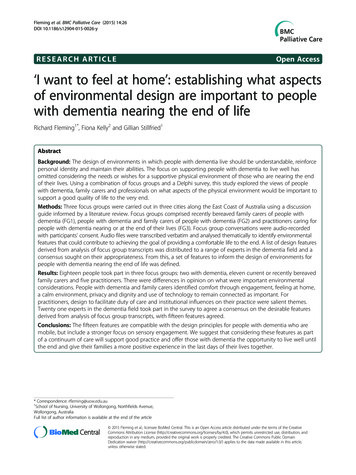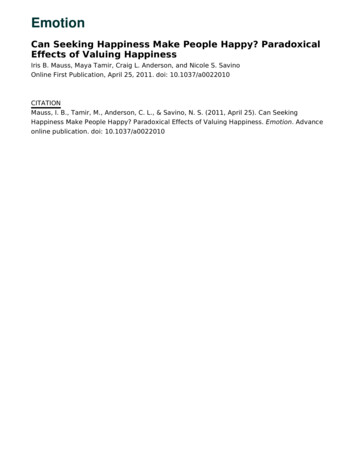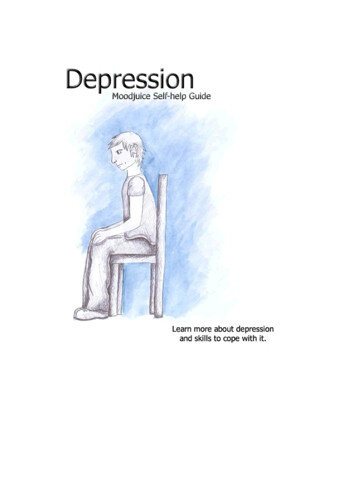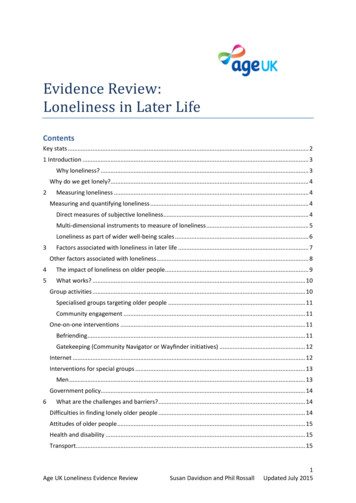
Transcription
Fleming et al. BMC Palliative Care (2015) 14:26DOI 10.1186/s12904-015-0026-yRESEARCH ARTICLEOpen Access‘I want to feel at home’: establishing what aspectsof environmental design are important to peoplewith dementia nearing the end of lifeRichard Fleming1*, Fiona Kelly2 and Gillian Stillfried1AbstractBackground: The design of environments in which people with dementia live should be understandable, reinforcepersonal identity and maintain their abilities. The focus on supporting people with dementia to live well hasomitted considering the needs or wishes for a supportive physical environment of those who are nearing the endof their lives. Using a combination of focus groups and a Delphi survey, this study explored the views of peoplewith dementia, family carers and professionals on what aspects of the physical environment would be important tosupport a good quality of life to the very end.Methods: Three focus groups were carried out in three cities along the East Coast of Australia using a discussionguide informed by a literature review. Focus groups comprised recently bereaved family carers of people withdementia (FG1), people with dementia and family carers of people with dementia (FG2) and practitioners caring forpeople with dementia nearing or at the end of their lives (FG3). Focus group conversations were audio-recordedwith participants’ consent. Audio files were transcribed verbatim and analysed thematically to identify environmentalfeatures that could contribute to achieving the goal of providing a comfortable life to the end. A list of design featuresderived from analysis of focus group transcripts was distributed to a range of experts in the dementia field and aconsensus sought on their appropriateness. From this, a set of features to inform the design of environments forpeople with dementia nearing the end of life was defined.Results: Eighteen people took part in three focus groups: two with dementia, eleven current or recently bereavedfamily carers and five practitioners. There were differences in opinion on what were important environmentalconsiderations. People with dementia and family carers identified comfort through engagement, feeling at home,a calm environment, privacy and dignity and use of technology to remain connected as important. Forpractitioners, design to facilitate duty of care and institutional influences on their practice were salient themes.Twenty one experts in the dementia field took part in the survey to agree a consensus on the desirable featuresderived from analysis of focus group transcripts, with fifteen features agreed.Conclusions: The fifteen features are compatible with the design principles for people with dementia who aremobile, but include a stronger focus on sensory engagement. We suggest that considering these features as partof a continuum of care will support good practice and offer those with dementia the opportunity to live well untilthe end and give their families a more positive experience in the last days of their lives together.* Correspondence: rfleming@uow.edu.au1School of Nursing, University of Wollongong, Northfields Avenue,Wollongong, AustraliaFull list of author information is available at the end of the article 2015 Fleming et al.; licensee BioMed Central. This is an Open Access article distributed under the terms of the CreativeCommons Attribution License (http://creativecommons.org/licenses/by/4.0), which permits unrestricted use, distribution, andreproduction in any medium, provided the original work is properly credited. The Creative Commons Public DomainDedication waiver ) applies to the data made available in this article,unless otherwise stated.
Fleming et al. BMC Palliative Care (2015) 14:26BackgroundThere are growing calls for end of life care to be provided, not just to those with cancer [1, 2] but for peoplewith coronary heart disease, older people [3] and indeedall people approaching the end of life regardless of age,diagnosis, gender, ethnicity, sexual orientation, religiousbelief, disability or socio-economic status [4]. In the UK,the Department of Health [4] also proposes that highquality care at end of life should be available whereverthe person may be – at home, in a care home, a hospice,hospital or elsewhere.The case for making palliative care available for peoplewith dementia has been made on the grounds of equity,need and on the basis that adopting a palliative approachwould improve the quality of care available to peoplewith dementia; throughout their journey [5]. In the UK,the philosophy of palliative care emphasizes care andcommunication over inappropriate intervention andtreatment [6]; it attempts to redirect the emphasis ontechnology-driven medicine. The European Associationfor Palliative Care, in their white paper, reached a consensus on eleven domains of optimal palliative care forpeople with dementia, including ‘for dying people, acomfortable environment is desirable’ [7], however thereis no elaboration on what this might entail. In Australia,guidance on palliative and end of life care emphasizes aperson-centered [8] approach which meets physical,psycho-social and spiritual needs and addresses aspectsof the environment such as ensuring bedrooms are ofsufficient size to accommodate visitors and equipment,and that sensory support is offered [9].The association between advanced age and dementiaindicates a rapidly increasing prevalence of people withdementia resident in the care home sector. In Australiaduring 2006-2007, 72.7 % of people admitted to carehomes were 80 years of age, an increase from 64.1 % in1998-1999 [10]. Worldwide it is estimated that fourfifths of people in care homes have a dementia [11]. TheNational End of Life Care Intelligence Network reportthat the largest percentages of deaths of people with dementia occur in hospital (36%), followed by nursinghomes (30%) and supported accommodation (26%) [12].Relatively small percentages die in their own homes, inhospices, or elsewhere.The increasing numbers of people entering care homesin a frailer state and policy drivers to provide high qualitypalliative and end of life care to people with dementia [4,13] have prompted consideration of what a palliative approach for dementia care entails [7]. This paper exploresone aspect of care for people with dementia nearing theend of life: what environmental characteristics are important to promote living as well as possible until death [14].A ‘dementia friendly’ environment has been describedas ‘a cohesive system of support that recognises thePage 2 of 14experiences of the person with dementia and best provides assistance for the person to remain engaged ineveryday life in a meaningful way’ (p.187) [15]. Any definition of a dementia friendly environment should consider both the experiences of the person with dementiawithin the environment and also the social, physical andorganisational environments which impact on these experiences. Lyman (p.15) [16] states that ‘care providersand care recipients inhabit the unique world of dementiacare. If designers and programme planners can understand this world from the perspective of persons livingwith dementia, an “enabling” environment can minimisedisability and provide opportunities to live a meaningfullife, despite losses and challenges associated [withdementia].’The importance of ensuring that the design of buildings meets the needs of people with dementia and makessense to them has been championed by Marshall [17].Marshall’s summary of the key principles of design anddementia continues to be used as the quality standard ofgood design, with substantial empirical support for theseprinciples generated in subsequent years [18]. She assertedthat design should: Compensate for disabilityMaximise independenceEnhance self-esteem and confidenceDemonstrate care for staffBe orientating and understandableReinforce personal identityWelcome relatives and the local communityAllow for the control of stimuli.A further set of principles for the design of care settingsfor older people with dementia have been developed [19,20]. These principles state that environments that are usedto provide care ‘aimed at maintaining the abilities ofpeople with dementia should’: Be safe and secureBe smallBe simple and provide good ‘visual access’Reduce unwanted stimulationHighlight helpful stimuliProvide for planned wanderingBe familiarProvide a variety of spaces with opportunities forboth privacy and community Provide links to the community Be domestic and homelike.Such principles allow staff and management to gain anunderstanding of problems that are caused by the environment in which people with dementia live, allowing for
Fleming et al. BMC Palliative Care (2015) 14:26the implementation of short and long-term plans for improving the environment to support care [21].The focus of “dementia friendly environments” [15]has been on maintaining independence and well-beingthrough engagement and is therefore aimed at thosewho are relatively fit and mobile. Despite the relativelylarge body of work on identifying optimum design principles for people with dementia [22, 18], with a focus onmaintaining independence and balancing sensory stimulation according to needs, there is little literature andeven less research into design that focuses on the needsof those with advanced dementia [23], or those with dementia who are nearing the end of life or dying. With anincreasingly frail population of people with dementia receiving care in formal care settings, current design principles might not accurately reflect this population’sneeds and wishes; this might particularly be the case forpeople with dementia approaching the end of their lives.The overall aim of this study was to identify the environmental features that are desirable in buildings used toprovide care for people with dementia nearing the endof their lives.The specific objectives of this research were to: gain a better understanding of the needs and wishesof people with dementia nearing the end of theirlives, and those of their families, gain a better understanding of the physical resourcesrequired by the staff caring for them and identify a set of features that will inform the design ofphysical environments that accommodate the needsof people with dementia nearing the end of their lives.Fig 1 Mixed methods approach used in this studyPage 3 of 14We aimed to reach these objectives by using a mixedmethods design (Fig. 1). Ethical approval for the studywas obtained from the University of Wollongong/SouthEastern Sydney and Illawarra Area Health Service Human Research Ethics Committee (Australia) (Protocolnumber HE11/265). Ethical processes were followed toensure informed consent, anonymity, confidentiality andprevention of harm.MethodsThe end of the person with dementia’s life was conceptualised as occurring in the severe stage of dementia[24]. This stage is characterised by severe memory loss,disorientation to time and place, inability to function independently outside of the home, very restricted or nointerests and requiring total assistance with personalcare.Focus groupsFocus groups are a useful method to identify a range ofopinions by discussing a particular issue with a smallgroup of people [25]. Focus groups were used to explorethe needs and wishes of those with dementia, their families and those caring for them (practitioners) with respect to design of environments when nearing the endof life. The findings from a literature review [26] wereused to generate a list of topics to guide the focus groupdiscussions (Fig. 1).Three focus groups (FG) were carried out by two ofthe research team RF and FK in three cities along theEast coast of Australia during 2012. Both RF and FK areexperienced researchers who have conducted numerous
Fleming et al. BMC Palliative Care (2015) 14:26participant interviews and focus groups [27-31] and haveestablished research backgrounds in environmental design for people living with dementia [19-21, 18, 27, 28].A convenience sample of participants with dementiaand family carers were recruited via the Alzheimer’sAustralia Consumer Dementia Research Network.Members of the Dementia Research Network are peoplewith dementia who volunteer to provide comments on research applications and to offer suggestions for areas ofresearch. Practitioners were recruited by invitation via theNew South Wales and Australian Capital Territory Dementia Training Study Centre mailing list. FG1 involvedfour recently bereaved family carers of people with dementia: all female. Three were the wives of recently deceased people with dementia, the fourth was the daughterof a person with dementia in residential aged care. FG2 involved nine participants: seven female and two male. Fivewere the spouses of deceased people with dementia, twowere daughters of deceased people with dementia and twowere people with younger onset dementia. FG3 involvedfive participants, all female. Two were care workers, one acare home manager, one a dementia care educator andone a palliative care nurse researcher. All had experienceof caring for people with dementia nearing the end oftheir lives.All focus groups started with the researchers servingtea and coffee and offering participants food such asfruit and cakes. In this way an informal atmosphere wascreated in which participants who knew each other couldcatch up and those who didn’t could be introduced toPage 4 of 14each other. Formal introductions were made, informationsheets reviewed and consent forms signed. Topic guides(Table 1) developed using key themes arising from a literature review [26] were used to structure the focus groups.The focus groups were lively, with participants expressingopinions and experiences quite freely and listening respectfully to each person’s contributions. Each focus grouplasted approximately one and a half hours and was audiorecorded with participants’ consent. All voice files fromaudio recordings were transcribed verbatim. Field notesand notes of debriefing sessions following the focusgroups were made to record developments in thinkingand researchers’ impressions.Survey to identify desirable characteristicsDelphi surveys are an iterative method used to reachconsensus of a group of experts on a particular issue[32] and have been used to assist in defining palliationin dementia care [7]. In order to reach a consensus onthe principles of environmental design that might accommodate the needs of people with dementia nearingthe end of their lives, a total of 22 professionals in theareas of architecture and interior design for aged careand end-of-life and palliative care, sourced from a convenience sample of the contacts of the investigators,were invited to participate in a Delphi process. Twentyconsented and one who declined offered an alternate expert who accepted.The 21 experts surveyed included 10 experts in environmental design of care facilities for older people, eightTable 1 Focus group discussion pointsGroupDiscussion guidePeople with dementia1. What aspects of the design of your house/garden are important to you at the moment?Recently bereaved family members2. If you have been in hospital or a medical or nursing setting, can you describe aspects of the design of thesetting that you liked and/or disliked?3. What are the key design differences between a hospital and your home? How do they both make you feel?4. What changes would you like to make to a hospital setting that would make you feel more comfortable ifyou are in hospital or other medical setting?5. If you become frail or ill, what are the key things that you would like to have in place to help you feel morecomfortable?6. Expand on why they would make you feel better7. Expand on aspects of design you think would make you feel worse and why?Practitioners1. What are the key areas of importance to you when caring for someone with dementia who is frail and/ornearing the end of life?2. When someone with dementia is dying, what do you do to care for them?3. What are your concerns when caring for someone with dementia who is dying?4. From your experience of caring for someone with dementia who is dying, what aspects of the design of thephysical environment help or hinder the care you give?5. What aspects of the physical environment would you like to improve when you are caring for someone withdementia who is frail and/or nearing the end of life?6. If someone was restless in bed, what would you do to help make them more comfortable? How could thedesign of the setting help or hinder you with this?
Fleming et al. BMC Palliative Care (2015) 14:26experts in palliative and/or end of life care, one expert inadvanced dementia care, one expert in hospital intercommunication and one expert in end of life environments. Experts were from research (7) and practice (12)or both (2). Fifteen were based in Australia and six inthe UK. The average number of years of experience providing, developing or researching services for peoplewith dementia was 18.3 (ranging from 5 to 30 years) andthe average number of years providing, developing orresearching services for people with dementia in thefinal stages was 13.7 years (ranging from 0 to 30 years).The list of 11 desirable features for the environmentwhich were identified in the focus groups was developedinto a series of questions, each asking the professional torate their perception of the level of importance of thatfeature to people with dementia nearing the end of lifeon a 5-point Likert scale. The questionnaire then askedfor examples of how this feature might be seen in practice and for any features that may be missing from thelist presented. The questionnaire also asked a number ofdemographic questions and questions about level of experience and area of practice. The survey was administered using the online survey program, SurveyMonkey.The survey ran for five and a half weeks and one personalised reminder was sent during the survey period. Individual survey completions were not able to be determined asthe survey was anonymous. At the closing date, 21 participants had contributed to the survey and 18 had completedall questions.The list of desirable environmental features was refined following analysis of responses to the first survey.It included a list of the nine features with at least 50%strong support and a second list of six features that werederived from panel member comments. The refined listwas then circulated to all survey participants who wereasked to consider if any of the features should not be included, to provide any comments if they wished and toprovide any additional features if they felt any of highimportance were missing. Provision of comments wasoptional and participants were given three weeks to dothis. A total of nine participants contributed to the second round of the survey, eight participants completed allquestions.AnalysisFocus groupsFocus group transcripts were read thoroughly alongsideaudio files to ensure accuracy of transcription and togain a feel for what participants were saying. Transcriptswere then read carefully several times by one researcherto identify initial codes and themes based on the topicguides and issues arising during the focus groups [33].They were then reviewed by the other researcher alongsideinitial codes and themes to ensure accuracy. DiscussionsPage 5 of 14were held on emerging ideas and themes that would inform the development or adaptation of existing designprinciples. All focus group data were managed usingqualitative data management software NVivo8. From analysis of the focus groups, a list of 11 environmental features was identified to support the care of people withdementia nearing the end of life.Modified delphi surveyExpert panel ratings of the importance of each environmental feature were used to refine the initial 11-item list.Features that did not have at least 50% strong support(i.e. 50% or more of participants thought they were very,or extremely, important), where separated out into a second list. Free response examples provided by each participant were organised into items within each mainenvironmental feature. These items exemplified howeach feature could be realised in practice. Commentsmade throughout the survey as well as in response tothe question about whether panel members felt any features were missing, were thematically analysed and usedto develop a list of additional exemplars and features forthe second round of the survey. No additional featureswere provided in the second round, but comments madeby panel members who participated in that round of thesurvey were incorporated into the exemplars of desirableenvironmental features to produce the final list.ResultsViews of people with dementia and family carersComfort through engagementFamily carers spoke spontaneously and movingly abouthow they worked to maintain engagement with the person with dementia they were caring for, up until the endof life. This ranged from engagement with the senses,spiritual engagement and social engagement, with thegoal of providing comfort to the person. The two participants with dementia were also clear that being able (andhelped) to engage by whatever means was possiblewould also be important to them as they neared the endof their lives. Participants talked in different ways abouthow the environment might sooth or comfort the personwith dementia. They were clear that attempts must bemade to ensure that care was aimed at ensuring comfortthrough engagement with the senses, even towards theend of life:Perhaps if they’re not well anymore, right at the end,and comfort is something that can be adjusted,adjustable bed with, you know, ventilation and awindow nearby and, you know, music nearby, so thatif you sense that’s what’s of comfort to them, would beimportant. (FG1F4)
Fleming et al. BMC Palliative Care (2015) 14:26This family carer describes how she worked to helpher husband engage his senses with the things that hadbeen important to him: bird song, sunshine and thescent of flowers:We got (husband) out every day that the sun wasshining and when it wasn’t freezing cold, he camehome mid-winter and we’d put his beanie on and gethim into the recliner wheelchair and out into thegrass in the garden lots of garden, lots of birds. He’san ornithologist, loved birds, could tell them all bytheir sound, you know, and we’ve got lots of jasmine,and stuff like that, around so, very early spring, likenow, the smell of the jasmine was around and youcould see him responding to it. So, in terms of thosethings, and just feeling the sun, just feeling thewarmth of the sun was incredibly important.(FG1F4)Using outside spaces to facilitate engagement with thesenses was seen as very important by carers, even forthose who were nearing the end of their lives:I do think it’s most people like outdoors, there arevery few people who don’t like looking at the leavesfluttering on the trees and being outdoors, I think,there isn’t enough attention and enough space forpeople to be taken outside, to be able to be takenoutside, I think, that’s crucial. (FG1F5)Page 6 of 14But, even, in residential care, I don’t think that thefocus should be keeping a person in their room, even ifthey’re no longer mobile, they have to get out of thatroom, I think that’s terribly important . (FG1F5)Others described the sense of peace that can arise withthe quiet, gentle, loving company of family:But, it was having (his son) sitting next to him, holdinghis hand, talking about some of the things that werethere, just, periodically, feeding him, talking somemore, just sitting quietly together, just that sense,gentle light in the room, you know, moderate sounds,just, they were the things in terms of the make up ofthe environment. (FG1F4)In an example of recognising the potential of socialengagement for providing comfort, this carer describedthe comfort her father gained from having the cat sleepon the bed with him:Something I did with my dad is he used to get up andwander every night and purely by accident one nightthe cat got stuck in his room, and the next morning, heactually didn’t get up that morning, and the nextmorning when I went into his room the cat was curledup in bed with him. And so from then on for the lasttwo years, every night, I put the cat in bed with him,and he actually died at home with the cat aroundhim. (FG2F6)Spiritual engagement was seen in broader terms by afew participants, for example, this participant with dementia viewed spirituality (in its broadest sense) as away of nurturing her core self:As this might not always be feasible, an alternative wassuggested by some carers: pretend dogs and cats, whichlook very realistic and may also meet comfort needs. Forexample:It depends how you define spirituality, I always sayyou've got your cognition and then you've got youremotions and then there's the inner you. That could bethe herb garden or the music or the pets, or it could beyour faith system or all of the above. But I think itdoes becomes much more important (near the end oflife), because if you can’t do all of that rememberingand factual things, and you can’t do the talking andthe emotional, who everybody is, then you really areyour true self, and you can be nurtured as your trueself. (FG2F1)I don’t know, I was just going to say there was a ladyhere a few weeks back and her family said she wasvery restless so as soon as they gave her this little(pretend) cat and a basket or a rug or whatever it was,anyway, she just sat there like this and she was (FG2F8)The importance of social engagement was raised byseveral participants and included engaging with family,friends, the community of residents if in long-term careand pets or dolls. For example, this carer was clear thatpeople, regardless of mobility or frailty, should experience the company of others:And she began to open up and speak. (FG2M2)Another participant also recognised the importance ofbeing able to engage socially with who or whatever couldprovide comfort at that particular time:I find that where (wife) is, everybody’s different andthey have different things. One lady has a doll, a bigdoll, it’s almost life-like. I thought it was a doll. Othershave dogs and octopuses, all kinds of things. But alady has a little poodle, and she takes it round to the
Fleming et al. BMC Palliative Care (2015) 14:26various ones that she knows loves a dog and puts it inthe bed with her. And just to see the reaction on peopleis just wonderful. (FG2M3)All of these accounts are founded on the convictionthat it is possible to provide comfort to people with dementia until they die and that this can be achievedthrough engaging the person either through whateversenses are possible or appropriate, through spiritualmeans and through the company of family, friends orother means such as dolls or pets.Feeling at home/familiarFeeling at home or the sense that the environment or aspects of it were familiar to the person with dementiawas seen as important to participants in focus groups 1and 2. For example:I tend to think that people with dementia do wantfamiliar; it’s the change that is difficult to cope withand the familiar things are personal things, if we’retalking about residential care, to bring in personalthings of theirs, whether it was his music, I know myhusband did a lot of photography as a hobby and hehad the photographs there and when he did go intorespite, we took the same pictures, I think, that wasimportant to him. (FG1F5)This participant with dementia was clear in her wishesfor the end of life and referred to the concept of aging inplace, where people will live and die in the same familiarplace:Because the last thing I want to happen to me is to bemoved. I want to feel at home. (FG2F1)This carer describes the facility where his wife is andstresses the importance of the familiar feel her own possessions give to it:Where my wife is at present, she has the mostwonderful room,, and they told me when I wentthere to make it like it was her home. So I broughtin some of her paintings and photographs,everything that’s all around the wall, TV. Andoutside she’s got a door that opens out into a littleporch which has a table on it and two chairs, andshe can look straight out into the car park and seeme coming in. (FG2M3)The overwhelming opinion of carers and people withdementia is that care settings must have a homely feel;this will be achieved through having the person’s ownbelongings, ornaments, pictures, television etc. in it.Page 7 of 14Calm environmentThe importance of ensuring a calm environment wasstressed by carers and people with dementia, whetherthis was at home or in a care setting. This participantwith dementia was clear she did not want to be in anoisy environment, what was important for her wascalm, peace and quiet:I think the calm and peaceful environment is for me,walking into an environment where there’s lots of noiseand other surroundings going on seems to affect mycoping skills and how I would interact. And I feel thatcertainly that will stay until the end, the quietpeaceful, serene surroundings seems to be the mostimportant thing, it does impact greatly I feel. (FG2F9)This participant with dementia also expressed her distaste of noise and overwhelming stimuli:Nobody seems to understand, but it’s visual stuff,visual clutter. When I was visiting last year in adementia ward, was not only obviously the soundlevel, the TV and the radio and the staff talking loudlyto each other, but it was a smaller area, there werelots of people, lots of tables, people coming in and outand then the occupational therapist had made stuff,which was hanging everywhere and it was just Andthen there were loads of those walkers everywhere; itwas just visually really, really stressful. I would justgo there for an hour and I’d be exhausted, And I oftenthink no wonder people in nursing homes are justsitting there like that
the person may be – at home, in a care home, a hospice, hospital or elsewhere. The case for making palliative care available for people . of people with dementia nearing the end of their lives. We aimed to reach these objectives by using a mixe











